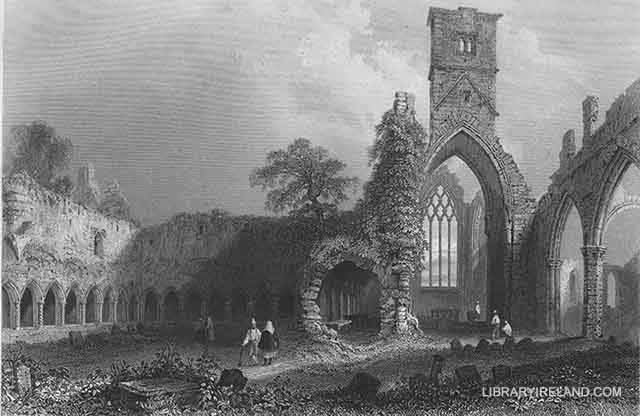Sligo Abbey
SLIGO ABBEY is an object well deserving the notice of the antiquary. It was originally erected by Maurice Fitzgerald, lord-justice, about the year 1252. In 1414 it was destroyed by fire, but very shortly afterwards re-erected in its present style of architecture. It is a picturesque ruin of very large dimensions, divided into several apartments. The first has a beautiful window of carved stone, under which is the altar, also of cut stone. Here are two ancient monuments, one bearing date 1616, and the other belonging to one of the O'Connor kings. The latter is in good preservation, the figures and inscriptions being very legible. At the top is represented our Saviour on the cross, and below this, in separate compartments, are the figures of O'Connor and his wife, kneeling, their hands lifted up in the act of supplication. The steeple or dome is still entire, supported upon a carved arch or cupola, the inside of which is also carved. Adjoining these are three sides of a square of beautifully carved little arches, of about four feet in height, which seem to have been anciently separated from each other, and probably formed cells for confession and penance. Almost all the little pillars are differently ornamented, and one in particular is very unlike the rest, having a human head cut on the inside of the arch. There are several vaults throughout the ruins, containing the remains of skulls, bones, and coffins. The abbey and yard are still used as a burying-place.
Sligo is a busy little place, with a large retail trade, and an export trade larger than any other town in that part of Ireland. "It is," says Mr. Inglis, "a decidedly improving town. With the exception of two or three months in the year, there is employment for the people; and I did not observe many symptoms in the town of a pauper population. In the general aspect of the population, I perceived an improvement. I saw fewer tatters than I had been accustomed to; and fewer bare feet on market-day, when all wear shoes and stockings who can. I observed, also, that a large portion of the men wore clean linen shirts. The poor in Sligo are not increased in numbers by ejectments in the country. This is not the practice of the landlords here. They do not drive for rent or eject; they excuse the arrear, and allow the tenant to quit. This has the appearance, at first sight, of generosity, but it is, in fact, matter of necessity. Exorbitant rents are irrecoverable by driving, or by any other means. How much more rational it would be to lower rents, and actually to receive the amount of one's rent-roll?
"I found at Sligo a considerable change in the dress and manners of the people. Here, I could not discover any traces of Spanish origin. The women were no longer seen with the hoods of their cloaks thrown over their heads; nor were the men seen with huge top-coats, as in the more south-western parts. The women wore caps and bonnets; and the girls nothing on their heads. There appeared to be much love of dress among all ranks; and among the lower classes, singular discrepancies. A well-dressed woman might be seen carrying in her arms a baby, decked out in muslin, lace, and ribbon, and by her side, a boy running with bare feet and ragged clothes; or a girl with a tattered gown, and without shoes and stockings, might display a fine shawl or a handsome frill."

